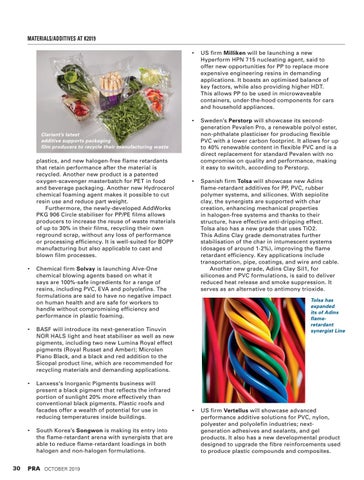Materials/Additives at K2019 • US firm Milliken will be launching a new Hyperform HPN 715 nucleating agent, said to offer new opportunities for PP to replace more expensive engineering resins in demanding applications. It boasts an optimised balance of key factors, while also providing higher HDT. This allows PP to be used in microwaveable containers, under-the-hood components for cars and household appliances.
Clariant’s latest additive supports packaging film producers to recycle their manufacturing waste
plastics, and new halogen-free flame retardants that retain performance after the material is recycled. Another new product is a patented oxygen-scavenger masterbatch for PET in food and beverage packaging. Another new Hydrocerol chemical foaming agent makes it possible to cut resin use and reduce part weight. Furthermore, the newly-developed AddWorks PKG 906 Circle stabiliser for PP/PE films allows producers to increase the reuse of waste materials of up to 30% in their films, recycling their own reground scrap, without any loss of performance or processing efficiency. It is well-suited for BOPP manufacturing but also applicable to cast and blown film processes.
• Chemical firm Solvay is launching Alve-One chemical blowing agents based on what it says are 100%-safe ingredients for a range of resins, including PVC, EVA and polyolefins. The formulations are said to have no negative impact on human health and are safe for workers to handle without compromising efficiency and performance in plastic foaming. • BASF will introduce its next-generation Tinuvin NOR HALS light and heat stabiliser as well as new pigments, including two new Lumina Royal effect pigments (Royal Russet and Amber); Microlen Piano Black, and a black and red addition to the Sicopal product line, which are recommended for recycling materials and demanding applications. • Lanxess's Inorganic Pigments business will present a black pigment that reflects the infrared portion of sunlight 20% more effectively than conventional black pigments. Plastic roofs and facades offer a wealth of potential for use in reducing temperatures inside buildings. • South Korea’s Songwon is making its entry into the flame-retardant arena with synergists that are able to reduce flame-retardant loadings in both halogen and non-halogen formulations.
30
OCTOBER 2019
• Sweden’s Perstorp will showcase its secondgeneration Pevalen Pro, a renewable polyol ester, non-phthalate plasticiser for producing flexible PVC with a lower carbon footprint. It allows for up to 40% renewable content in flexible PVC and is a direct replacement for standard Pevalen with no compromise on quality and performance, making it easy to switch, according to Perstorp. • Spanish firm Tolsa will showcase new Adins flame-retardant additives for PP, PVC, rubber polymer systems, and silicones. With sepiolite clay, the synergists are supported with char creation, enhancing mechanical properties in halogen-free systems and thanks to their structure, have effective anti-dripping effect. Tolsa also has a new grade that uses TiO2. This Adins Clay grade demonstrates further stabilisation of the char in intumescent systems (dosages of around 1-2%), improving the flame retardant efficiency. Key applications include transportation, pipe, coatings, and wire and cable. Another new grade, Adins Clay Sil1, for silicones and PVC formulations, is said to deliver reduced heat release and smoke suppression. It serves as an alternative to antimony trioxide. Tolsa has expanded its of Adins flameretardant synergist Line
• US firm Vertellus will showcase advanced performance additive solutions for PVC, nylon, polyester and polyolefin industries; nextgeneration adhesives and sealants, and gel products. It also has a new developmental product designed to upgrade the fibre reinforcements used to produce plastic compounds and composites.
